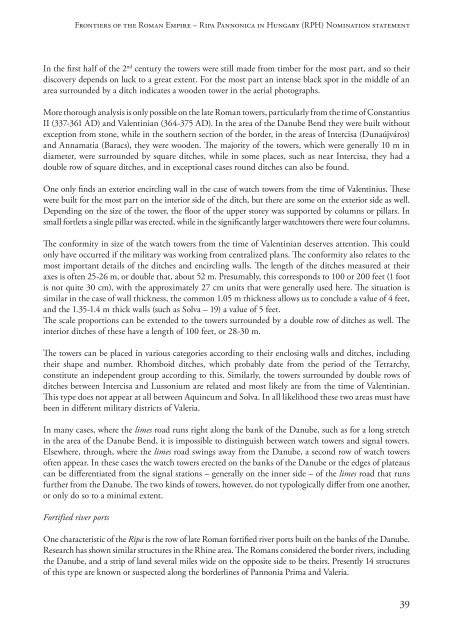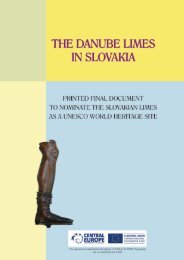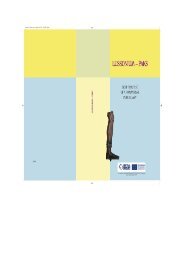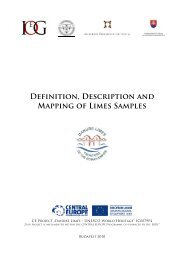the PDF version! - Danube Limes
the PDF version! - Danube Limes
the PDF version! - Danube Limes
You also want an ePaper? Increase the reach of your titles
YUMPU automatically turns print PDFs into web optimized ePapers that Google loves.
Frontiers of <strong>the</strong> Roman Empire – Ripa Pannonica in Hungary (RPH) Nomination statement<br />
In <strong>the</strong> first half of <strong>the</strong> 2 nd century <strong>the</strong> towers were still made from timber for <strong>the</strong> most part, and so <strong>the</strong>ir<br />
discovery depends on luck to a great extent. For <strong>the</strong> most part an intense black spot in <strong>the</strong> middle of an<br />
area surrounded by a ditch indicates a wooden tower in <strong>the</strong> aerial photographs.<br />
More thorough analysis is only possible on <strong>the</strong> late Roman towers, particularly from <strong>the</strong> time of Constantius<br />
II (337-361 AD) and Valentinian (364-375 AD). In <strong>the</strong> area of <strong>the</strong> <strong>Danube</strong> Bend <strong>the</strong>y were built without<br />
exception from stone, while in <strong>the</strong> sou<strong>the</strong>rn section of <strong>the</strong> border, in <strong>the</strong> areas of Intercisa (Dunaújváros)<br />
and Annamatia (Baracs), <strong>the</strong>y were wooden. The majority of <strong>the</strong> towers, which were generally 10 m in<br />
diameter, were surrounded by square ditches, while in some places, such as near Intercisa, <strong>the</strong>y had a<br />
double row of square ditches, and in exceptional cases round ditches can also be found.<br />
One only finds an exterior encircling wall in <strong>the</strong> case of watch towers from <strong>the</strong> time of Valentinius. These<br />
were built for <strong>the</strong> most part on <strong>the</strong> interior side of <strong>the</strong> ditch, but <strong>the</strong>re are some on <strong>the</strong> exterior side as well.<br />
Depending on <strong>the</strong> size of <strong>the</strong> tower, <strong>the</strong> floor of <strong>the</strong> upper storey was supported by columns or pillars. In<br />
small fortlets a single pillar was erected, while in <strong>the</strong> significantly larger watchtowers <strong>the</strong>re were four columns.<br />
The conformity in size of <strong>the</strong> watch towers from <strong>the</strong> time of Valentinian deserves attention. This could<br />
only have occurred if <strong>the</strong> military was working from centralized plans. The conformity also relates to <strong>the</strong><br />
most important details of <strong>the</strong> ditches and encircling walls. The length of <strong>the</strong> ditches measured at <strong>the</strong>ir<br />
axes is often 25-26 m, or double that, about 52 m. Presumably, this corresponds to 100 or 200 feet (1 foot<br />
is not quite 30 cm), with <strong>the</strong> approximately 27 cm units that were generally used here. The situation is<br />
similar in <strong>the</strong> case of wall thickness, <strong>the</strong> common 1.05 m thickness allows us to conclude a value of 4 feet,<br />
and <strong>the</strong> 1.35-1.4 m thick walls (such as Solva – 19) a value of 5 feet.<br />
The scale proportions can be extended to <strong>the</strong> towers surrounded by a double row of ditches as well. The<br />
interior ditches of <strong>the</strong>se have a length of 100 feet, or 28-30 m.<br />
The towers can be placed in various categories according to <strong>the</strong>ir enclosing walls and ditches, including<br />
<strong>the</strong>ir shape and number. Rhomboid ditches, which probably date from <strong>the</strong> period of <strong>the</strong> Tetrarchy,<br />
constitute an independent group according to this. Similarly, <strong>the</strong> towers surrounded by double rows of<br />
ditches between Intercisa and Lussonium are related and most likely are from <strong>the</strong> time of Valentinian.<br />
This type does not appear at all between Aquincum and Solva. In all likelihood <strong>the</strong>se two areas must have<br />
been in different military districts of Valeria.<br />
In many cases, where <strong>the</strong> limes road runs right along <strong>the</strong> bank of <strong>the</strong> <strong>Danube</strong>, such as for a long stretch<br />
in <strong>the</strong> area of <strong>the</strong> <strong>Danube</strong> Bend, it is impossible to distinguish between watch towers and signal towers.<br />
Elsewhere, through, where <strong>the</strong> limes road swings away from <strong>the</strong> <strong>Danube</strong>, a second row of watch towers<br />
often appear. In <strong>the</strong>se cases <strong>the</strong> watch towers erected on <strong>the</strong> banks of <strong>the</strong> <strong>Danube</strong> or <strong>the</strong> edges of plateaus<br />
can be differentiated from <strong>the</strong> signal stations – generally on <strong>the</strong> inner side – of <strong>the</strong> limes road that runs<br />
fur<strong>the</strong>r from <strong>the</strong> <strong>Danube</strong>. The two kinds of towers, however, do not typologically differ from one ano<strong>the</strong>r,<br />
or only do so to a minimal extent.<br />
Fortified river ports<br />
One characteristic of <strong>the</strong> Ripa is <strong>the</strong> row of late Roman fortified river ports built on <strong>the</strong> banks of <strong>the</strong> <strong>Danube</strong>.<br />
Research has shown similar structures in <strong>the</strong> Rhine area. The Romans considered <strong>the</strong> border rivers, including<br />
<strong>the</strong> <strong>Danube</strong>, and a strip of land several miles wide on <strong>the</strong> opposite side to be <strong>the</strong>irs. Presently 14 structures<br />
of this type are known or suspected along <strong>the</strong> borderlines of Pannonia Prima and Valeria.<br />
39











